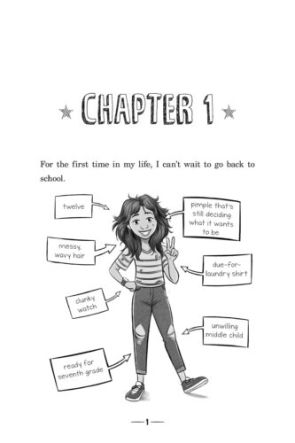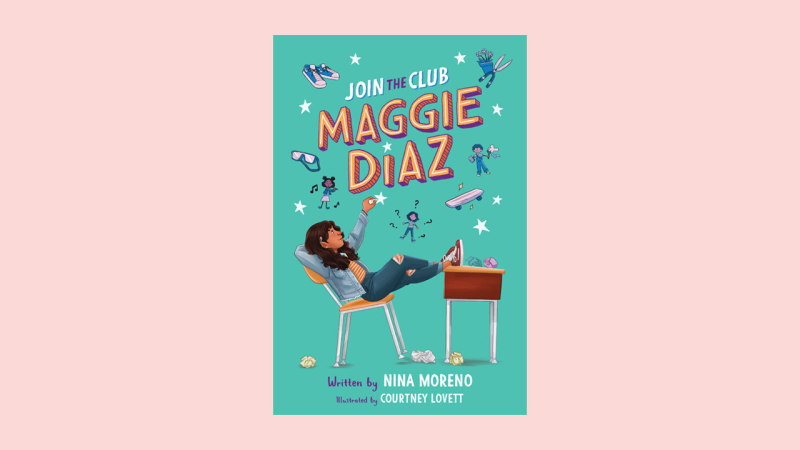We interviewed Nina Moreno, author of the Join the Club, Maggie Diaz, as part of a series celebrating Hispanic and Latine Heritage Month. The titles we’re highlighting this month illuminate the diversity and breadth of the Hispanic and Latine experience, as well as the power of growing up in a multicultural household. The characters in these stories are exploring how their Latine heritage, their communities, and their interests and talents converge to make them who they are.

What inspired you to write this book? You’ve previously written YA novels: what made you want to tell Maggie’s story for a middle-grade audience?
Join the Club, Maggie Diaz was my lockdown book. I started writing it early in 2020 while sitting beside my daughter doing virtual school and the three of us just really wanted to see our friends and find a little independence. I loved getting to explore the power of humor in a coming-of-age story that felt so personal to my own experience, but I was so nervous about writing middle-grade! It was really important to me to get the voice and humor right. Middle-grade readers deserve their books to feel like theirs. We’re asking for space on their shelves and should always respect that.
Maggie describes her mom and her parenting style as “Very Cuban.” How does Maggie’s Cuban background inform her journey and who she is?
I was born in Miami in the 80s and being Cuban American there didn’t make me all that different from most of the kids around me. But when we left that Miami bubble for a small town in Georgia, all of a sudden, I understood what it felt like to be Very Cuban. It was a total culture shock. I was the only Latina in my class, and as a sensitive, shy new kid, feeling so obviously different at that age was really tough. Like how utterly tragic it was that my parents were way stricter compared to my white friends and I could never go to sleepovers. Or how odd it was to my classmates that my grandparents not only lived with us but that they didn’t speak English. And don’t get me started on the weekends when my dad would roast a whole pig practically in our front yard.
Being twelve and in the seventh grade is tough, but when I met other kids of immigrant parents and different cultures, I realized how relatable these moments actually were. And in writing Maggie’s story, I wanted to explore those feelings and experiences in a funny, angst-ridden, stubbornly optimistic way. So, while Maggie doesn’t get to go to sleepovers and has to share her room with her abuela and is pretty sure she’s the only kid her age to not own their own phone, she’s just navigating the seventh grade like everyone else around her.
Maggie’s family is really important to her. What did you want to convey about Maggie’s home life?
Whether I’m working on young-adult or middle-grade, I love writing about families. I grew up in a multi-generational home, and those relationships shaped me in a million little ways. And I really wanted to show a full picture of Maggie’s journey. Because middle school is this strange and awkward time in our lives where we really start to figure out who we are outside of our families. Just as Maggie is discovering pieces of herself through her adventures in all those clubs, she’s also finding answers thanks to all the people in her life. Who is School Maggie vs. Home Maggie? Does she act differently when she’s around her parents vs. when she’s talking to a teacher? Is she just copying her perfect older sister? (Ugh, never.) Is it okay to respond in English when her grandmother speaks to her in Spanish? Maggie’s world is opening up and she’s finding herself within it.
Why is it so important for Maggie to find something that defines her? It says so much about her that even as she is looking for ways to define herself, she often chooses activities that will help her give back to her community and fulfill the needs and wants of the people she loves!
 For Maggie, it starts to feel like finding a hobby, skill, or team will answer all those new and intimidating questions about identity. I remember envying the band kids, because no matter if they also struggled in math like I did, or were having a rough morning, once they stepped in that band room, it seemed like they knew exactly who they were and where they fit. Like a confirmed cafeteria table, so many of us just want that sense of place.
For Maggie, it starts to feel like finding a hobby, skill, or team will answer all those new and intimidating questions about identity. I remember envying the band kids, because no matter if they also struggled in math like I did, or were having a rough morning, once they stepped in that band room, it seemed like they knew exactly who they were and where they fit. Like a confirmed cafeteria table, so many of us just want that sense of place.
And it’s definitely frustrating for Maggie when the answer doesn’t come easily to her, but it’s within that struggle that she starts to let go of her expectations and realize all the unexpected things about each club that she does like. And so often it does come back to community for her. So, while it’s not just one big shiny answer, she realizes it doesn’t have to be.
The book explores so many parts of Maggie’s life: her changing family structure, school, extracurriculars, friendships - and it gets to be pretty challenging. What do you hope readers take away from watching Maggie navigate all of this?
I hope readers take away that it’s one hundred percent okay to feel like you’re the only one who doesn’t have it all figured out. And while seventh grade is a great time to explore new interests, so are all the grades and years after. Because finding ourselves is a lifelong journey full of an infinite amount of evolutions. Even within the story, as we watch Maggie’s curiosity take her from club to club in search of answers, we also see that her mom is on her own self-reflective journey as she takes on her last year of college after just having her third child. And Abuela is figuring out who she is after losing the love of her life and having to move in with her daughter. Everyone around us is on their own journey.
There are so many amazing illustrations that make us feel like we’re a part of the story. How did you collaborate with illustrator Courtney Lovett to visualize Maggie and her world?
 This was my first time working with an illustrator and it was such a new and exciting way for me to conceptualize a story as I tried to find the right balance between prose, dialogue, and illustration ideas. As soon as the team showed me Courtney’s first sketches, I was blown away. Maggie’s story truly came alive. Courtney’s vision of Maggie is so warm and full of love for her and her community. We both really related to Maggie’s big emotions and chaotic energy and Courtney captured it all so beautifully. And getting to see Maggie’s plans, imagination, and thought processes through her charts, graphs, and doodles is so fun! It really feels like you’re holding her journal and getting to be part of her seventh-grade life.
This was my first time working with an illustrator and it was such a new and exciting way for me to conceptualize a story as I tried to find the right balance between prose, dialogue, and illustration ideas. As soon as the team showed me Courtney’s first sketches, I was blown away. Maggie’s story truly came alive. Courtney’s vision of Maggie is so warm and full of love for her and her community. We both really related to Maggie’s big emotions and chaotic energy and Courtney captured it all so beautifully. And getting to see Maggie’s plans, imagination, and thought processes through her charts, graphs, and doodles is so fun! It really feels like you’re holding her journal and getting to be part of her seventh-grade life.
What is one quality you share with Maggie, and one you wish you shared?
I wish I was as bold and optimistic as Maggie! It takes serious guts to chase new experiences and not be deterred by failing. Each time a plan doesn’t work for Maggie, she dusts herself off and makes a new one, and I love that about her.



